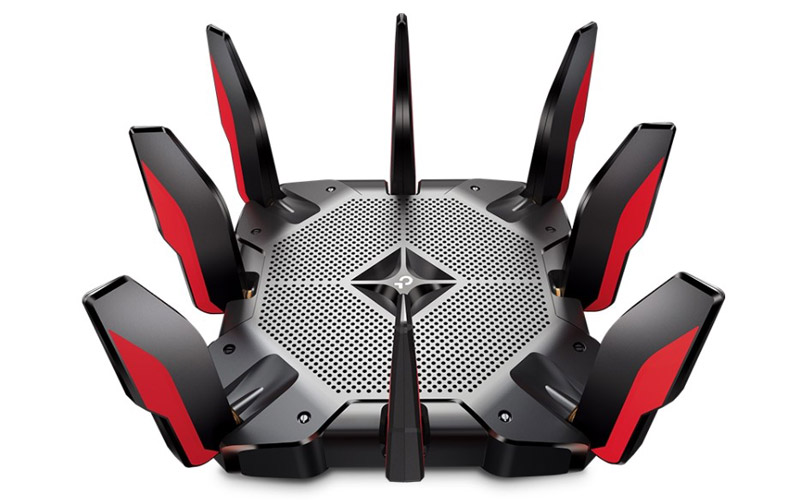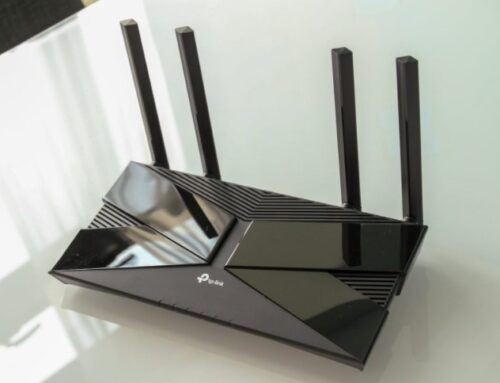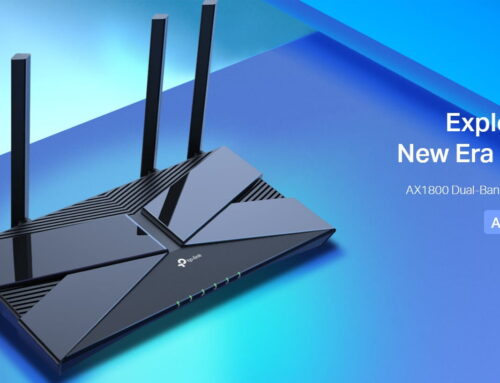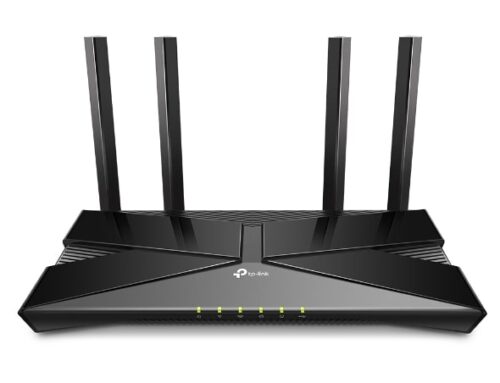It’s not a leap to suggest that a significant proportion of people don’t pay much consideration to their router when they’re using it. After all, it is essentially simply a box that broadcasts a Wi-Fi signal in certain ways. While not for everyone, TP-Link recommends the Archer AX11000 Next-Gen Tri-Band Gaming Router for those who are knowledgeable about wireless technology and/or dedicated gamers who would like to guarantee they’re receiving the best connection possible when playing games online. From here on out, we’ll talk about it as the TP-Link AX11000 with no qualification.
Despite the fact that the TP-Link Archer AX11000 is a follow-up model to the Archer C5400X, which utilized 802.11 ac (Wi-Fi 5), it has a similar appearance to the newer, Wi-Fi 6-equipped router we’ll be looking at here in this review. The TP-Link Archer AX11000 is intended to offer a top-of-the-stack router that is geared specifically at the gaming industry, and it comes with a price tag to match that goal.
Despite this, the Archer AX11000 is still cheaper than flagship routers from companies like Netgear and Asus, with prices ranging between $405 and $430. And, because of its strong design, it certainly seems like it belongs in this company. Let’s take a closer look to see if this model is a good value for the money.
Where To Buy TP-Link Archer AX11000 Router:
Design
It should come as no surprise that the TP-Link Archer AX11000 is housed in a big chassis because the amount of power it provides. This is a horizontally oriented router made of an almost matte-black plastic that, due to its square form, takes up a significant amount of desktop space on the desktop. On top of that, it features a big brick of a power supply that takes up even more room, as well as a total of eight antennae, all of which are painted in the same color as the chassis.
Compared to other rivals and even inferior routers, all of the antennas are locked in place and can not be fine-tuned by moving them about. Together with a huge number of holes on the top, there is an LED in the center position on the top of the router that is, luckily, controllable by turning it off.
The TP-Link Archer AX11000, with its black textured cabinet and red highlighted antennae, screams gaming router to me, and it’s easy to see why. With dimensions of 7.2 by 11.3 by 11.3 inches (HWD), it is significantly larger than the Asus RT-AC5300 gaming router (2.6 by 9.6 by 9.6 inches) and will demand a significant amount of dedicated desktop space.
TP-Link Archer AX11000 is geared up with eight non-adjustable high-performance detachable antennas and an LED indication that illuminates solid white when everything is operating well, solid red when the router loses Internet access and solid orange when Wi-Fi is deactivated. Overall, it has a pleasing appearance, but if there is one drawback to this wireless router, it is that it will take up a substantial amount of space wherever it is placed.
A plethora of I/O ports may be found on the back panel. There are eight gigabit LAN ports, a 2.5 Gb WAN port, a reset button, a power jack, and a power switch located on this side of the case. The Type A USB 3.0 port and the Type C USB 3.0 port are located on the right side of the router. A 1.8 GHz quad-core processor, 1 gigabit (GB) of RAM, and 512 megabytes (MB) of flash memory are housed within the device’s chassis.
The TP-Link Archer AX11000 is a tri-band router with 12 streams that can achieve (theoretical) data rates of as high as 1,148 megabits per second (Mbps) on the 2.4 GHz band and as high as 4,804 Mbps on each of the two 5 GHz bands. The AX11000 has a total of 12 streams and is capable of reaching data rates of as high as 1,148 Mbps on the 2.4 GHz band and up to 4,804 Mbps on each of the two 5 GHz Aside from that, it uses the most up-to-date 802.11 ax Wi-Fi 6 technology, which provides OFDMA (Orthogonal Frequency-Division Multiple Access), 1024 QAM (Quadrature Amplitude Modulation), Target Wake Time, WPA3 encryption, 4X4 MU-MIMO data streaming, beamforming, DFS (Dynamic Frequency Selection), and support for 160MHz channel bandwidth.

Archer AX11000 Security & Features
The TP-Link Archer AX11000 is geared up with the kinds of capabilities that you would expect from a high-end gaming router from a company like TP-Link. This features bandwidth testing and Quality of Service settings, each of which has five presets and a sixth parameter that allows the user to tailor the priority of traffic for complete granular control over the network.
Security-wise, the TP-Link Archer AX11000 is adequate, but not exceptional when seen through the lens of a consumer router. It all starts with compatibility for the most recent wireless encryption technologies. The Archer AX11000 is able of supporting WPA3 while being backward-compatible with earlier standards in the process.
This is demonstrated in the picture above, and we appreciate the fact that it is included in the box with no the need for a separate membership, and that it employs a security database that receives updates from Trend Micro, as shown in the screenshot above. Malicious Content Filter and an Intrusion Protection System are both included, and each may be adjusted independently of the other. In Addition, Parental Controls are available, which is to be expected with a router of this kind.
Archer AX11000 Performance
Our performance evaluation of the TP-Link Archer AX11000 began with a throughput test performed using our Netperf performance software. Our ‘Near’ test is performed at a distance of 8 feet, while our ‘Far’ test is performed on a separate level around 30 feet away. During our testing, we discovered that the AX11000 had a reasonable performance on the 5 GHz frequency and only slightly better performance on the 2.4 GHz frequency.
Network congestion testing revealed that the Archer AX11000 performed better across Ethernet and 5 GHz connections, with 2.4 GHz performance being the weakest connection in our test results. On our Overwatch gaming test, we got a good FRAPS score of 128.5 frames per second when linked over Ethernet and with no any background movies.
| Testing Configuration | QoS | FRAPS avg | Max | 8k dropped frames | Pingplotter spikes | Latency |
| Ethernet | no | 128.5 | 112 | n/a | 0 | 241 |
| Ethernet + 10 8k videos | no | 88.1 | 38 | 24.70% | 2 | 261 |
| Ethernet + 10 8k videos | yes | 118.6 | 103 | 25.10% | 3 | 138 |
| 5 GHz | no | 120 | 109 | n/a | 0 | 235 |
| 5 GHz + 10 8k videos | no | 15.4 | 0 | 37.50% | 2 | 148 |
| 5 GHz + 10 8k videos | yes | 129.3 | 107 | 36.20% | 7 | 137 |
| 2.4 GHz | no | 124 | 108 | n/a | 0 | 161 |
| 2.4 GHz + 10 8k videos | no | 62.1 | 29 | 29.70% | 13 | 168 |
When we added the 10 8K films to overload our 300 Mbps connection, the frame rate went down significantly to 88.1 frames per second. When we switched on the Game Accelerator and set the Quality of Service for gaming to high, the game increased to 118.6 frames per second. While the frame rate in the game increased, we were disappointed by the high lost frame rate of 25.1 percent, which we felt was excessive for a high-end gaming router of this kind.
In our tests, we found that the router’s performance was better on 5 GHz and weaker on 2.4 GHz, where we saw a significant number of spikes on PingPlotter, indicating that it was not handling network congestion well. However, the framerate of 129.3 frames per second that we reached on Overwatch with video streaming congestion while using the 5 GHz frequency is noteworthy since it is a higher score than the one we received when using the Ethernet connection. Also remember that, despite the better frame rate, the PingPlotter spikes climbed to 7 and the number of missing video frames increased to 36.2 percent, both of which are greater than with a cable connection.
Verdict
When you consider that it costs just under $400, the TP-Link Archer AX11000 Next-Gen Tri-Band Gaming Router does not qualify as a cheap router. On the other hand, it is extremely fast and packed with features that will help you take your online gaming to the next level.
In addition, it includes eight gigabit LAN ports with link aggregation, USB C connection, and an additional 2.5 Gb WAN port for those who are fortunate enough to have access to a multi-gig switch or modem. Lifetime membership to the TP-Link HomeCare service is also included, which supplies anti-virus protection, parental controls with content filtering, and device prioritizing.
The service is administered through a sleek gamer-themed dashboard that allows you to monitor latency and system resources. All of this contributes to the TP-Link Archer AX11000 being named our Editors’ Choice among high-end Wi-Fi 6 routers.
Where To Buy TP-Link Archer AX11000 Router:










Leave A Comment